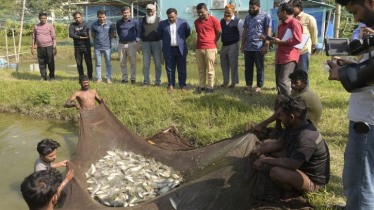
Fish feed requirements differ significantly between winter and summer, and these differences directly influence production costs and profit margins. For this reason, understanding proper feed application strategies during winter is essential.
The period from March to October is considered the most favorable for fish production, with the highest growth occurring during these months. When the average water temperature remains between 32 and 33 degrees Celsius, nursery feed for various species must contain 34 to 35 percent combined animal and plant protein, while grower feed should contain 27 to 28 percent. However, the winter environment is largely unfavorable for aquaculture.
As temperatures drop, feed intake decreases sharply. From November to February, low temperatures not only disrupt fish production but also trigger various diseases. Many farmers are unaware that the commonly used feeding practices in Bangladesh contribute significantly to winter fish diseases. While tilapia may continue to grow slightly during winter, most other species show no growth. Pangas, in particular, experiences weight loss as body fat begins to break down. Under these circumstances, winter grower feed should contain only 15 to 20 percent protein and 7 percent fat.
Research shows that maintaining all other feed components while adding high-quality vitamin premix can increase production by 15 to 20 percent. When vitamins are combined with minerals during feed formulation, production can rise by 20 to 25 percent. This lowers the feed conversion ratio and reduces production costs. In addition, vitamins and minerals significantly boost immunity, helping fish fight bacterial infections that become common in winter. Regular use of these nutrients, in the right proportions, can prevent many seasonal diseases.
Alongside protein, an appropriate amount of fat is essential in fish feed. One of the primary reasons for winter weight loss is that fish consume less feed, leading to the depletion of stored body fat. Ideally, feed should contain 6 to 7 percent fat, but this is often neglected in Bangladesh. Tests have found that some feed companies advertise 3 percent fat on their packaging yet supply feed with even less, sometimes below 2 percent. When fat levels are inadequate, fish lose their vibrant color, leading to reduced market value.
Many farmers know that increasing protein levels raises feed prices. Since fish require less protein in winter, using high-protein feed results in unnecessary waste and higher production costs. Waste can occur both directly and indirectly. In some cases, the fish consume the feed but fail to digest or utilize the excess protein, which is then expelled as waste. In other cases, fish may refuse the feed entirely, leading to direct waste. In both situations, the decomposing protein deteriorates water quality and increases bacterial growth. Fish are more vulnerable in winter due to weakened immunity, making them highly susceptible to such bacteria.
As feed accounts for the largest portion of production expenses, farmers must exercise extreme caution. If they are deceived by poor-quality feed or experience feed waste but fail to conduct regular weight checks, many farmers will not realize their losses until selling time. Given that fish farming has become a low-margin business, careful attention to feeding practices is essential for protecting farmers’ profitability.





